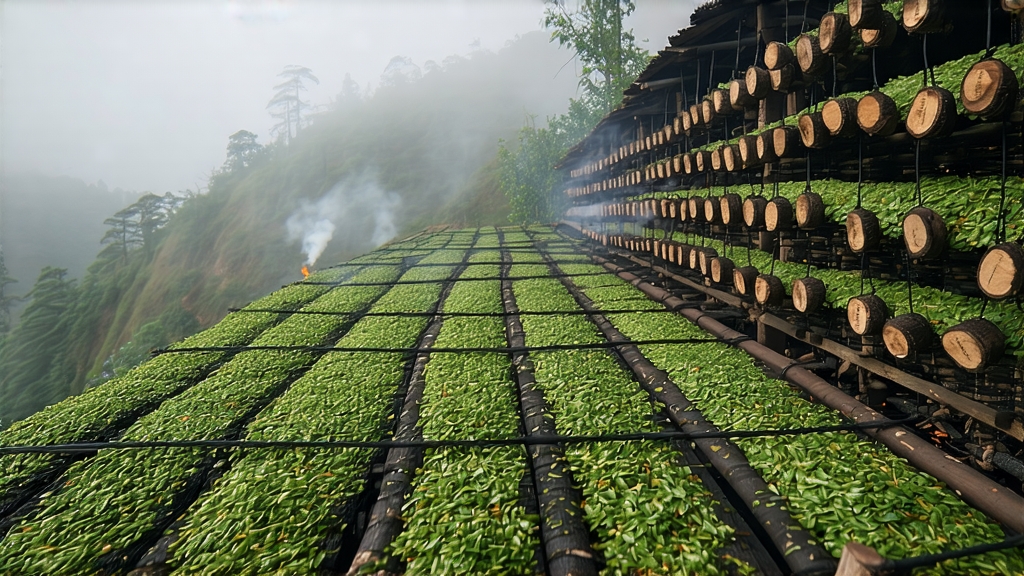
Long before the English added milk and sugar to their teacups, before Assam and Ceylon plantations even existed, the very first black tea in history was born in the rugged Wuyi Mountains of northern Fujian. Locals call it Zheng Shan Xiao Zhong—“Small Leaf from the Original Mountain”—but the world knows it as Lapsang Souchong. Its birth was accidental: Qing-era soldiers, so the legend goes, camped among tea factories during the tumultuous Ming-Qing transition. Their fires sped up leaf-drying and infused the tea with a scent of pine that proved irresistible to the Dutch traders anchored at the port of Xiamen. Thus, in 1604, Europe tasted black tea for the first time, and the global craving for “Bohea” began.
True Lapsang Souchong can only come from the 600–1,200 m elevation band inside the 60 km² Wuyi National Nature Reserve. Here, a subtropical monsoon climate collides with mineral-rich, weathered tuff soils, creating a diurnal temperature swing of 10 °C that slows leaf growth and concentrates amino acids. The indigenous cultivar is Xiao Ye Zhong (“small leaf species”), a Camellia sinensis var. sinensis landrace whose leaves are barely 3 cm long, yet thick enough to withstand the rigorous smoke-curing that follows.
Plucking takes place only between Qingming and Grain Rain, when two leaves and a bud are still tightly folded and silvery downy. The morning dew must evaporate before 9 a.m.; any residual moisture would dull the forthcoming sweetness. Once in the factory, the leaves undergo five meticulous steps that have remained virtually unchanged for four centuries:
- Withering: Bamboo trays are set above shallow charcoal braziers lined with local Masson pine. The temperature hovers at 28 °C for 8–10 hours, driving off 60 % of moisture while the wood releases a gentle resinous vapor.
- Rolling: A 25-minute ride in a slow-speed bamboo drum breaks cell walls without shredding the leaf; the goal is to expose polyphenol oxidase to atmospheric oxygen.
- Fermentation: The rolled leaves are nested in pine-wood boxes and covered with wet hemp cloth. For 3.5 hours the pile hovers at 24 °C and 85 % humidity, turning from jade to copper as catechins transform into theaflavins and thearubigins.
- Smoking & Drying: The decisive act. Fresh pine logs are split into finger-length sticks and lit in an earthen pit. A bamboo sieve is laid one metre above the flames; the tea is spread 2 cm thick and turned every five minutes for 45 minutes. Volatile guaiacol and syringol penetrate the leaf, freezing the oxidative clock and imprinting the signature campfire note.
- Sorting & Resting: After final charcoal baking at 80 °C, the tea is rested in unglazed clay jars for 30 days so the smoke softens and the intrinsic honeyed minerality can emerge.
The result is a leaf that is glossy, tar-black and slightly curved like a monk’s eyebrow. When you open a fresh tin, the first aroma is not smoke but dried longan and cacao; the pine appears only as a lingering back-note, never acrid or kerosene-like—the tell-tale difference between authentic Zheng Shan and the cheaper, chemically scented copies sold elsewhere.
To brew Lapsang Souchong Western-style, use 2.5 g per 250 ml of soft water at 95 °C and steep for 3 minutes. The liquor glows like antique mahogany, bright enough to read newsprint through. Sip once: a wave of dried plum and roasted sweet potato rolls across the tongue; sip twice: the Wuyi mineral bite arrives, reminiscent of wet slate after a summer storm; sip thrice: the pine retreats into a whisper of rosemary and frankincense. Milk is unnecessary; lemon is sacrilege.
For gongfu aficionados, a 120 ml Yixing zi-sha teapot seasoned only with smoked teas unlocks deeper strata. Rinse 5 g of leaf for five seconds to awaken the aromatics, then proceed with flash infusions starting at 10 seconds, adding five each steep. The first four cups chart an arc from caramelised fig to pipe tobacco; by the fifth